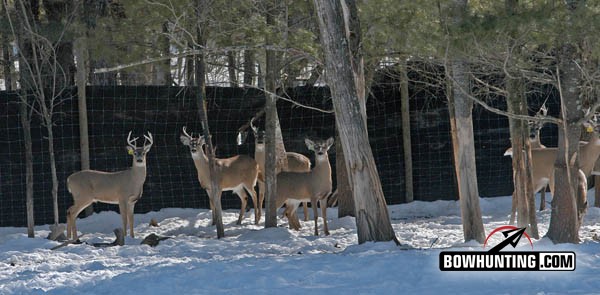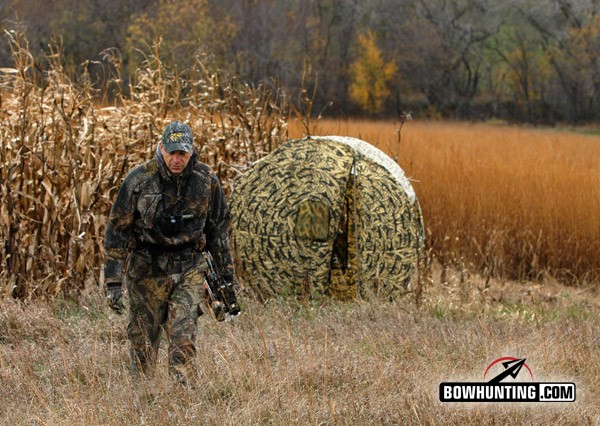LAST UPDATED: May 8th, 2015
Wisconsin used $465,000 from its cherished Stewardship Fund in late March to buy an 80-acre farm in the middle of the state that will remain closed to the public indefinitely because it once housed North America’s worst case of c hronic wasting disease.
The Wisconsin Department of Natural Resources bought the property, located west of Almond in Portage County, from Patricia Casey. Her boyfriend, Stan Hall, used nearly 70 acres of her land for his Buckhorn Flats deer farm, which was enclosed with an 8-foot high fence.
Wisconsin officials discovered CWD there in September 2002. Forty months of litigation ensued before Hall let the U.S. Department of Agriculture “depopulate” the large pens in January 2006. The shooters killed 76 deer, 60 of which carried CWD, a nearly 80 percent infection rate.
Wisconsin is home to more than 600 deer or elk ranches. (Patrick Durkin photo)
In all, 82 Buckhorn Flats whitetails tested positive for CWD between 2002 and 2006, according to Donna Gilson, spokeswoman for the Department of Agriculture, Trade and Consumer Protection. She said the Hall farm remains the most CWD-infected property on the continent, and probably the world. Further, two other Wisconsin game farms that previously did business with Buckhorn Flats pro duced nine CWD cases.
Because game-farm deer are private property, Hall was paid for his “losses.” He received $135,976 ($6,386 from Wisconsin and $129,590 from the federal government) for the 76 deer the USDA shot, and four female deer that died during the 40-month legal standoff, Gilson said. All told, Casey and Hall received nearly $601,000 for sick deer and contaminated land no one else would want.
Although CWD spreads slowly in the wild, the prions thought to cause CWD remain infectious for years. Therefore, the Wisconsin DNR can’t allow public access to its new land, fearing contaminated dirt could leave on shoes and boots to be spread elsewhere.
So why would the DNR, with Gov. Scott Walker’s approval, and pay about $94,000 more than the property’s appraised value for this toxic-waste site? And why would it make the purchase with funds usually reserved for protecting critical habitats for the public, especially after Gov. Walker froze most Stewardship spending in early February?
“Stan Hall had the state over a barrel,” said George Meyer, executive director of the Wisconsin Wildlife Federation. Meyer said federal regulations only required Hall to maintain the property’s fence for five years after the USDA killed the deer. If the state hadn’t bought the property, Hall and Casey could have neglected or removed the fence, thereby exposing wild deer to infectious prions.
“This cost is a small price compared to the price we’d pay later if CWD spread,” Meyer said. “It’s unusual, but it’s wise.”
Wisconsin now owns the Buckhorn Flats game farm, but it won’t be open to public hunting. (Patrick Durkin photo)
The costs don’t end there. The DNR must now maintain the fence, and it might build a second high-fence for an estimated $40,000 inside the perimeter for added insurance. Further, the agency will likely negotiate with neighbors to remove trees that could fall on the fence(s) and create openings.
Meanwhile, the state will regularly collect soil from the property for tests on laboratory mice to monitor prion contamination and infection.
The research might not end there. With grants and financial support from hunting organizations, officials hope this could become a unique deer-research facility. By capturing deer, and collaring and monitoring them, researchers could test vaccines or see if prions infect the deer.
Mule deer that contracted CWD at a Colorado facility in 1977 were exposed only 2.2 years after the previous herd was removed and the grounds disinfected. It’s already been five years since Buckhorn Flats held deer. Would healthy deer get sick at Buckhorn Flats if turned loose there now?
Whatever happens next, hunters shouldn’t forget what they were told when Wisconsin discovered CWD in February 2002. That is, CWD is relevant to all Wisconsinites, and requires the combined efforts of the DNR, DATCP, University of Wisconsin, and Department of Health and Human Services.
Yet nine years later, although Buckhorn Flats was the DNR’s responsibility when this storm hit, and DATCP’s responsibility ever since, we’re now hijacking habitat money to cover the aftermath.

 By
By 





